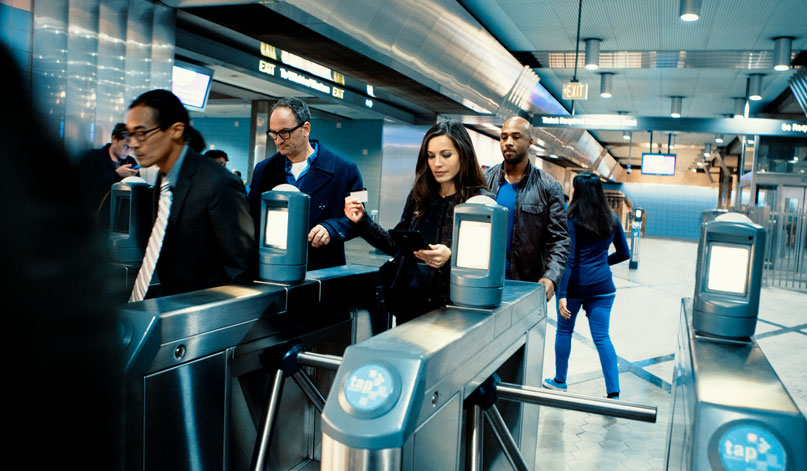The term “smart cities” conjures a range of images. Sustainable buildings that monitor and manage themselves … from security to resource use to climate control. Autonomous vehicles that interact with intelligent infrastructure to whisk us safely and seamlessly from Point A to Point B and back again. And, an expanding range of other benefits enabled by hyper-fast hyper-connectivity and the hyper-innovation it makes possible.
But in the midst of it all, there’s one huge benefit that’s often overlooked: smart cities will have the power to take accessibility and inclusiveness to a whole new level.

As they come online, vast smart city networks will one day power connections among personal devices (like smart phones and thermostats) and city services (think power grids and snowplows). These innovations open the door to new levels of mobility, accessibility and inclusion, offering, for example, an array of solutions that could enhance independent living for those with disabilities:
- Intelligent crosswalks that adjust timers for people with mobility limitations or communicate traffic information to blind pedestrians
- Mobility applications to help plan and implement trips across different modes of transportation – with an alternative text feature to translate visual elements like maps, graphs and pictures
- Accessible guidebooks that apply augmented reality, smart features and community services to welcome and engage tourists with disabilities
- Smart refrigerators that not only track the use and expiration of various foods but notify caregivers and automatically reorder when supplies get low
- Next generation 9-1-1 systems that support voice, real-time text, and video and transfer data from wearable electronics and sensors back to emergency services, in real-time
- Smart energy grids that automate the production and distribution of electricity to businesses and homes – prioritizing those where critical medical equipment is in use
The tip of a highly diverse iceberg
Sitting at the intersection of technology and accessibility, inclusive smart cities represent immense scale. By current estimates, the smart cities market is expected to grow from $308 billion in 2018 to $717 billion in 20231. Meanwhile, smart cities of the world will continue to expand globally (New York, Seoul and Reykavik are just three cities already recognized as smart)2. It’s the tip of a highly diverse iceberg that will one day house a population in which one in four people in the US – more, as the population ages – already lives with a disability.
As enabling technologies like 5G come online and the pace of smart city development intensifies, AT&T leaders recognize the importance of ensuring accessibility is built into planning from the earliest stages. “Inclusiveness should be at the forefront of every smart city strategy,” said Roman Smith, AT&T director of social innovation and community development. “With more than a billion people on this planet having some form of disability, designing solutions that account for individual needs makes sense from a business and policy standpoint.”
“Technology is not the limiting factor anymore. The limiting factor is us.”
– Dr. Aaron Bangor, AT&T
An idea whose time has come
As recently as 2016, the AT&T Advisory Panel on Access & Aging, made up of national experts on technology, aging and disability, identified accessibility as a critical gap within smart city initiatives in the business community. Charged with considering ways for next generation technology to bridge the digital divide, the group gravitated to one central question: As industry leaders, how can we apply smart city technology to advance accessibility and inclusion for all people?
AT&T seized the opportunity to influence smart city planning for the better. In collaboration with BSR™, the global non-profit dedicated to business for social responsibility, the team published a white paper titled Smart Cities for All: A Vision for an Inclusive and Accessible Urban Future. “This was our first attempt to start a conversation about how smart cities can improve accessibility,” said Dr. Aaron Bangor, AT&T director of Corporate Accessibility and Technology. “Because the tech is still emerging, smart cities offer a real opportunity to design systems from the ground up that are inherently accessible and inclusive.”
“As we think about accessibility, inclusion and social responsibility, smart cities offer an opportunity to address the needs of underrepresented groups around the world,” Roman said. The idea resonated with industry partners who hadn’t yet viewed smart city planning through an accessibility lens.
For Aaron, it was a call to action. “Why isn’t anyone talking about this already?” he asked. “The disability angle was completely new territory.”
A story of collaboration and involvement
Starting a conversation is one thing, bringing it to life something else altogether. “As access to big data, low latency networks, 5G and more make new things possible, the challenge will be coordinating emerging solutions from within a diverse ecosystem of innovators,” said Aaron. “Smart cities are not something one person, group, government or company can do alone. This will be a story of collaboration and involvement.”
And, therein lies the challenge. In an ecosystem with hundreds of innovators, everybody must work together if underlying solutions are to develop in a way that is inclusive of the wider population. “What do innovators need to know about universal design to ensure that their creations break down barriers, rather than unknowingly perpetuate the digital divide?” Aaron asked.
Responding to this challenge, AT&T partnered with the non-profit Smart Cities for All as well as the cities of New York and Chicago. That collaboration resulted in the publication of Inclusive Innovation Playbook with a goal to establish a common process and tools and define responsibilities for key roles for use by everyone who touches smart city planning.

A vision that demands more than technology
An inclusive smart city that enables independent living for all people who are living with disabilities ―it’s an enticing concept. Efforts to bring it to life, however, will require a degree of innovation that extends well beyond the limits of technology itself. The fulfillment of this vision demands a shared mindset and collective approach that emphasizes listening, learning and working together.
“Technology is not the limiting factor anymore. The limiting factor is us,” Aaron points out. “We must be intentional in thinking about the whole community. We must remember that technology is a tool that serves us – and it should be used to advance everybody’s needs.”
The point is clear, and the window of opportunity is now. By cultivating awareness and establishing common practices, smart city planners can instill a mindset that is human-centric and emphasizes people from start to finish – leading to an outcome that is truly inclusive of all.
PR Archives: Latest, By Company, By Date
